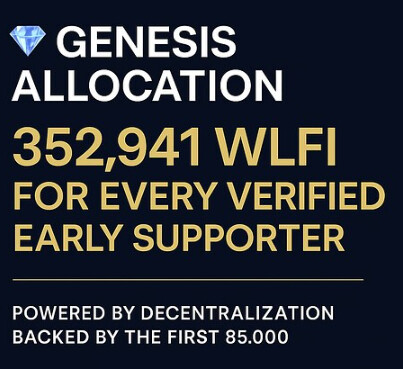 VOTE: YES
VOTE: YES
Because there’s only one way to prove that WLFI is truly decentralized.
This proposal represents much more than simply distributing tokens to @all . It’s about protecting the credibility, legitimacy, and future of the WLFI ecosystem.
It’s undoubtedly the most important moment since the project’s inception—a watershed moment that could either consolidate or compromise everything built so far.
 The world is watching.
The world is watching.
The market doesn’t forgive signs of disguised centralization, especially after so many projects promised Web3 and failed so ignominiously. And it’s not just the crypto community that’s paying attention:
Global regulatory authorities are closely monitoring the entire distribution and governance structure:
 SEC (USA)
SEC (USA) ESMA (European Union)
ESMA (European Union) BaFin (Germany)
BaFin (Germany) FCA (UK)
FCA (UK) CSRC (China)
CSRC (China) FSA (Japan)
FSA (Japan) MAS (Singapore)
MAS (Singapore) IOSCO (International Organization)
IOSCO (International Organization)
Any sign of favoritism, manipulation, or concentration could jeopardize the WLFI’s credibility and its compatibility with the future global regulatory environment.
If we want a project to be regulation-proof, it needs to prove this from the outset with fair, transparent distribution, and consistency with Web3 principles.
 Lessons from the past: when poor distribution ruined major projects:
Lessons from the past: when poor distribution ruined major projects:
 ICP (Internet Computer)
ICP (Internet Computer)
It promised massive decentralization and a revolution in the internet, but failed due to concentrated distribution, lack of clarity, and centralized governance. The result: a collapse in trust and price.
 EOS
EOS
It raised over $4 billion in its ICO, but failed to deliver on its promise of decentralization. Decisions were left in the hands of a small group of dominant validators, and the project lost relevance and community support.
 SUSHISWAP (Chef Nomi case)
SUSHISWAP (Chef Nomi case)
Despite initial success, the founder sold a significant portion of his tokens prematurely, which generated widespread distrust and nearly destroyed the project, which only survived after the community took control.
 SOLANA (initial concentration case)
SOLANA (initial concentration case)
Although technically advanced, the project still faces criticism and regulatory risks due to the high concentration of tokens among insiders and VCs, which calls into question its neutrality and true decentralization.
 ARBITRUM (reverted DAO case)
ARBITRUM (reverted DAO case)
In 2023, the community approved a governance proposal that the foundation itself decided to ignore, transferring tokens anyway. The result was a crisis of confidence in the project’s DAO model, affecting its legitimacy.
 APTOS
APTOS
It emerged from the legacy of the Diem project (Facebook), with extremely opaque tokenomics, limited airdrops, and favoritism toward insiders, which generated severe criticism and doubts about its neutrality.
All these examples show that good technology or sophisticated marketing are not enough.
Without fair distribution and transparent governance, no project survives the test of time.
 WLFI is not a meme and cannot be treated as such.
WLFI is not a meme and cannot be treated as such.
We are building a protocol with serious ambitions: infrastructure, decentralized governance, and regulatory resilience.
We are not dealing with speculative memecoins, such as:
 DOGE — which started as a joke and remains highly concentrated.
DOGE — which started as a joke and remains highly concentrated.
 PEPE — with purely speculative dynamics and opaque distribution.
PEPE — with purely speculative dynamics and opaque distribution.
 SHIBA INU — whose initial supply has also raised several concerns about manipulation.
SHIBA INU — whose initial supply has also raised several concerns about manipulation.
These assets are fueled by hype and coordinated market movements, and while they may generate temporary gains, they have no commitment to the principles of the real Web3.
WLFI aims for something much bigger:
Creating a real, open, and self-managed DAO.
Distributing power, not capitalizing on hype.
Being a solid foundation for the future of Web3 and decentralized financial infrastructure. Therefore, we must have a clean, fair foundation, consistent with the values we proclaim.
 Why this proposal is the only safe and legitimate way.
Why this proposal is the only safe and legitimate way.
The equal distribution of 30% of the Community Pool among the first 85,100 supporters is not only ethical:
It is strategically vital for the sustainability of the WLFI:
It avoids risks of concentration, manipulation, and security structure;
It guarantees real governance, with democratically distributed votes;
It prevents privileged enrichment and hidden favors;
It gives the project natural regulatory protection;
It creates a functional and legitimate DAO, not a simulation controlled by a few.
 Conclusion
Conclusion
If we want the WLFI to be a global symbol of real, auditable, and secure decentralization, there is only one path:
Fair, equal, and unquestionable distribution. Distributing this 30% equally among early supporters is not just a matter of fairness; it’s an existential requirement in the current crypto landscape.
 I vote YES with awareness, responsibility, and courage.
I vote YES with awareness, responsibility, and courage.
History is being written now, let it be built by everyone.
I VOTE YES.
![]() Proposal: Opinion on the Distribution of the 30% Allocation for Early Supporters (Prevent Centralization, Equal Distribution)
Proposal: Opinion on the Distribution of the 30% Allocation for Early Supporters (Prevent Centralization, Equal Distribution)![]() Proposal 1
Proposal 1![]() Proposal 2
Proposal 2